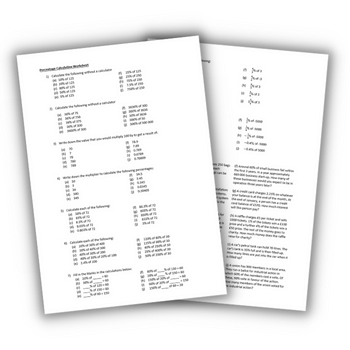This percentage calculations worksheet includes different types of percentage questions with answers.
It starts with using proportional reasoning to calculate percentages (Q1) and then other reasoning, ie 36% of 75 = 75% of 36 (Q2).
This worksheet is suitable for KS3, although this topic also appears on Foundation tier at GCSE level.
GCSE maths questions on percentage
The next two questions look at generating multipliers for different percentage values (including those less than 1% and greater than 100%). Students will then use this knowledge in calculation (Q5).
Questions 6-9 stretch the concept further, including finding fractional percentages and negative values, before setting questions in context.
Examples of questions on this worksheet include:
- Calculate the following without a calculator: 10% of 125; 750% of 250
- Write down the value that you would multiply 100 by to get a result of: 70; 0.789
- Write down the multiplier to calculate the following percentages: 30; 0.345
- Calculate each of the following: 20% of 30% of 400; 50% of 200% of 30
- Fill in the blanks in the calculations: 20% of ___ = 60; 150% of ___ of 60 = 20
- Calculate the following: ⅕% of 4
- Calculate the following: 50% of -200; -0.4% of 5000
- Work out the following: A sweet potato farm produces 250 bags of potatoes per hectare. 2% of each hectare is rotten. How many bags can be sold in each hectare?
Free teacher resources
These practice questions have been designed to allow pupils to try all significant aspects of the content, but also to notice something about the structure behind each content area.
Students will need to engage in reasoning to explain why they’re seeing the results they are.
We’ve limited worksheets requiring arithmetic to integer calculation so they can be used with pupils who may not yet be fluent in decimal/fractional arithmetic.
Where pupils have these pre-requisite skills, we recommend adapting the questions (where appropriate) to include this content.
Peter Mattock is an assistant headteacher and secondary mastery lead for the East Midlands South Maths Hub. He’s the author of Visible Maths and Conceptual Maths (Crown House Publishing). Follow Peter on Twitter at @MrMattock.
Explore percentage increase and decrease teaching resources for KS3 maths. Download 100+ problem-solving questions in our KS3 maths worksheets pack from White Rose Maths.














